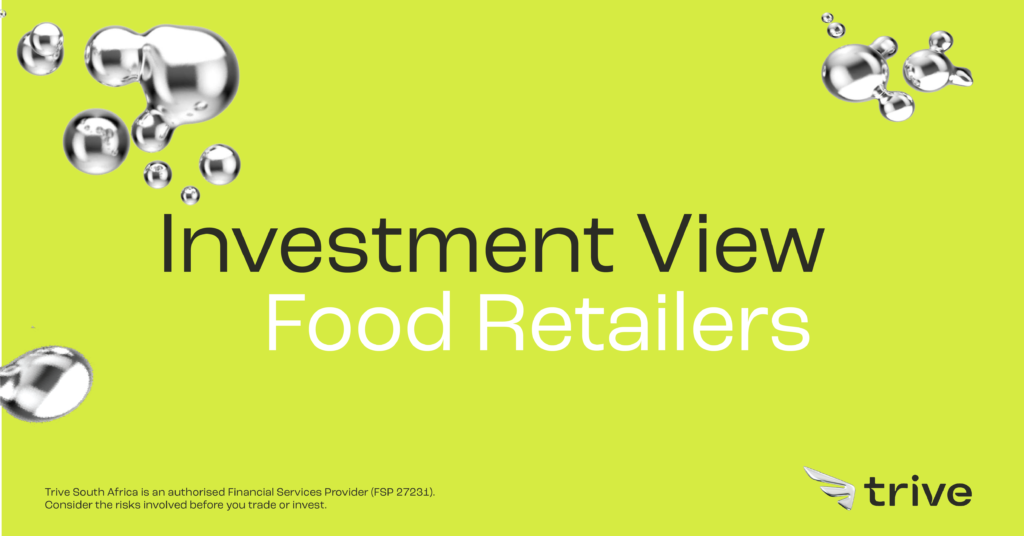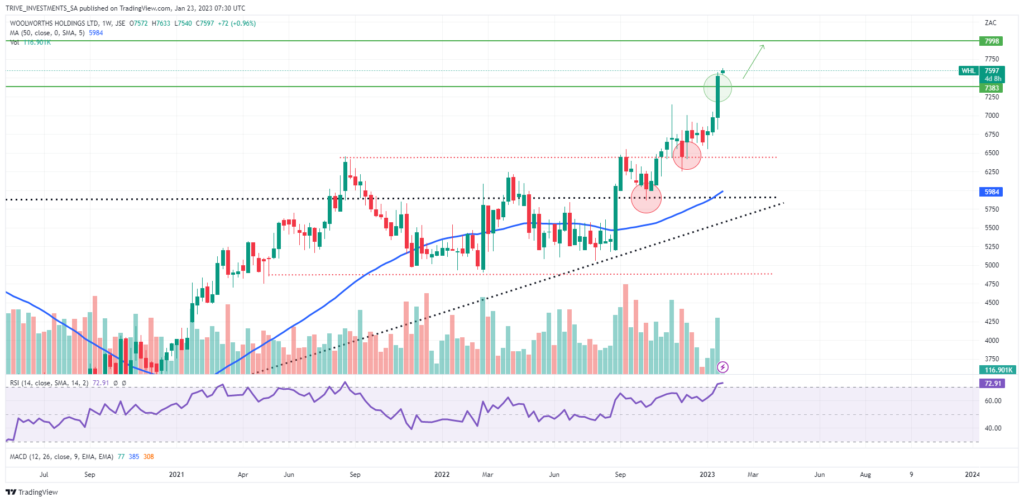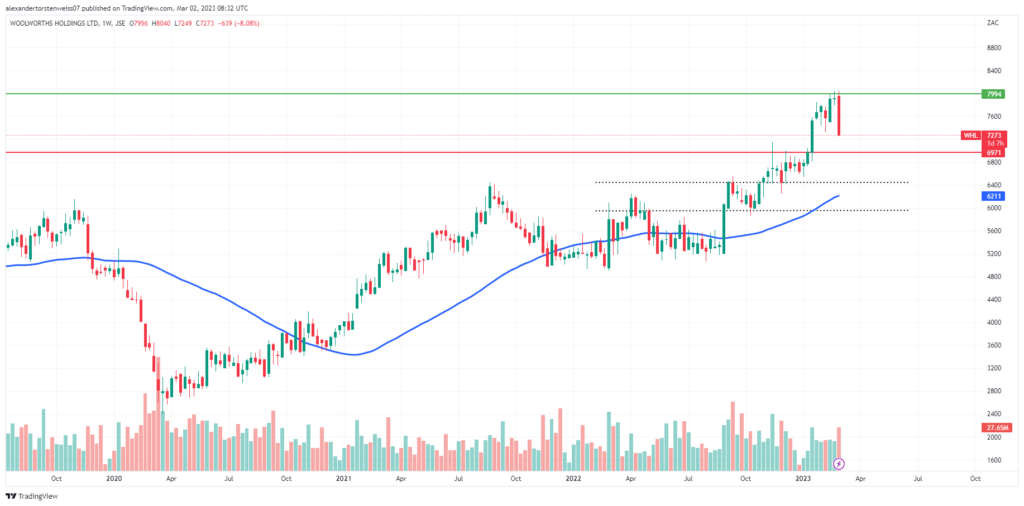
With the ongoing energy crisis proving to be a primary focal point for market participants in South Africa, many are looking at the big four food retailers to gauge which companies can best mitigate against the effects of rolling blackouts and power disruptions. South Africa’s big four retailers, Woolworths, Spar, Pick n Pay, and Shoprite, are faced with the cumbersome task of limiting food wastage amid periods of load shedding and remaining profitable despite a growing energy crisis in the country.
Woolworths Holdings Limited (JSE: WHL)
Supermarket giant and famous South African food retailer Woolworths Holdings Limited (JSE: WHL) saw its share price surge by nearly 6% on Thursday, 19th January after reporting that it expects half-year earnings to increase by as much as 80%, partially due to a recovery in Australia amid the easing of Covid-related restrictions as well as special Black Friday sales. Additionally, to focus on its core South African operations and improve overall financial well-being, Woolies has confirmed the sale of its Australian department store chain, David Jones. The transaction is expected to materially enhance the group’s balance sheet by removing approximately R17 billion in liabilities relating to the Australian luxury department store.
Technicals
The price action on Woolworths reached the first significant resistance level at R73.83, per our previous outlook on the retailer. If the positive market sentiment continues, the possibility exists that the next major resistance level at R79.98 could be reached. For the bear case, we might expect the price to retest the breakout at R73.83 a share, which will be watched closely.

Fundamentals
With customer demand and in-store purchases having increased tremendously in Australia and Black Friday sales boosting overall performance, headline earnings per share (HEPS) for the first half of 2023 are expected to increase by 70 to 80 percent, pushing half-year HEPS to lie within the range of 285.9 cents and 302.8 cents, a significant increase from 168.2 cents for the 26 weeks ended December 2021. Market participants, investors, and traders alike will look to see whether these expectations materialise when the group’s interim earnings results are officially released. Still, positive market sentiment is definitely behind the giant retailer.
2022 marked a financial year in which inflation and rising interest rates were the primary focal points. With inflation averaging 6.9% throughout 2022, a significant 2.4% above the central bank’s mid-range target rate of 4.5%, it is no surprise that the rising price environment took its fair toll on the average South African consumer. Consequently, Woolies reported that its financial services segment returned a highly respectable year-on-year turnover growth of 17.2% for the 26 weeks that ended December 2022, highlighting the increased customer reliance on credit.
Woolies’ share price reached a 52-week high of ZAR75.80 on Friday 20th, January on the back of expected earnings increases. Still, market participants will be looking to see how the group mitigates the effect of food wastage and loss in productivity due to the ongoing energy crisis in South Africa and rolling blackouts.
Update on Woolworths Holdings Limited (JSE: WHL) 02/03/2023
Famous South African multinational retail company, Woolworths Holdings Limited (JSE: WHL), reported record-high interim results for the half-year that ended 25 December 2022. Still, the group has warned investors of slower growth as the country’s ongoing energy crisis deteriorates profitability.
Woolies’ shareholders would have been more than impressed with the group’s stellar interim results. However, concerns over the company’s ability to mitigate South Africa’s power crisis saw the share price dip more than 3% on Wednesday, 1 March, as market participants began to price in an expected slowdown in growth. The group reported a 75% year-over-year surge in half-year earnings per share (EPS), while same-period turnover and concession sales increased 18.5% year-over-year to R49.9 billion. Given the relaxation of COVID-related restrictions in Australia, the famous retailer benefitted massively from the influx of shoppers returning to stores.
Despite record-high earnings and growth, Woolies struggles to grapple with “crippling power outages,” stating that the country’s energy crisis has “reduced its domestic adjusted operating profit by an estimated R15 million per month.” As consumer demand normalises in Australia, Woolies expects slower profit growth from continued operations due to the “debilitating power crisis.” CEO Roy Bagattini has informed investors that Woolies is working with property owners at shopping malls to “move towards renewable energy.”
Despite load-shedding eating away at Woolies’ profitability, dividend-conscious shareholders would have been rather pleased to see a 97% year-over-year increase in interim dividends per share (DPS) at 158.5 cents per share, up from 80.5 cents per share for the same period last year.
Technical Update
The price action on Woolies reached the significant resistance level at R79.94 (green line) as per our previous outlook on the retail giant, as bullish market sentiment sent the share price surging amidst record-high earnings growth. However, given Woolies’ statement on how the “debilitating energy crisis” is cutting domestic operating profit by an estimated R15 million per month, the share price has dipped more than 7% this week as bearish sentiment enters the market.
If the negative market sentiment continues, the price action could potentially continue to trend lower toward the next support level at R69.71 (red line), which will be watched closely as a potential entry point for long-term investors. If South Africa’s energy crisis worsens, the bears could see the price action tick down to lower support levels (black dotted lines). For the bull case, we might expect the price to retest the resistance level at R79.94 (green line), which will be watched closely for a potential breakout.

Summary
Despite recently reaching a 52-week high of R80.47 against the backdrop of superior earnings growth, Woolies warned investors of an anticipated slowdown in earnings growth as the giant retail battles against the country’s ongoing energy crisis.
The R69.71 support level (red line) will be watched closely for a potential entry point for long-term investors. Lower support levels could also be reached if bearish sentiment prevails amidst a collapsing national power supply. On the other hand, the price action can rebound and retest the R79.94 resistance level (green line), especially if Woolies manages to mitigate against the debilitating effects of rolling blackouts.
The Spar Group Limited (JSE: SPP)
Spar Group (JSE: SPP) has had a somewhat adverse and disappointing start to the 2023 financial year, with the group admitting to authorising three fictitious loans amounting to R11 million, raising concern amongst market participants and perversely impacting overall investor confidence.
Technicals
We saw a V-shaped recovery in Spar’s price action after the R112.98 support was tested at the start of the year as fundamental factors drove prices lower. The price action on the retailer is moving lower after the R139.72 resistance level (red circle) was tested and rejected. The price action could possibly find support at R129.37 and rebound higher if supported by fundamental factors. If the R129.37 support does not hold for the bear case, lower levels come back into focus.

Fundamentals
Despite the loans occurring approximately five years ago, the accounting irregularity does not bode well for the group’s reputation seeing that investor confidence was already low due to years of underperformance compared to its industry competitors.
To re-establish investor confidence and restore good faith in the group’s image, Spar is looking for a new CEO to ensure sound and appropriate corporate governance within its operations and bring the retailer’s performance back in line with its peers. With the current CEO, Brett Botten, stepping down from his position at the end of January, market participants will be looking to identify whether the new appointment can restore investor confidence and improve the group’s overall performance.
Big Four Retailer’s Financial Performance Roundup
Regarding Woolies’ year-on-year growth in total revenue of 1.66% for the 2022 financial year, Spar’s 5.99% year-on-year total revenue growth compares rather well. However, Spar’s 2022 net income margin of 1.59% for the 2022 financial year falls short of 4.64% for Woolies. Moreover, Spar’s current price-to-earnings (P/E) ratio of 11.8x is significantly lower than that of Woolies, whose current P/E ratio falls just short of 20x, at 19.7x.
Despite Spar returning a higher year-on-year total revenue growth compared to that of Woolies, Spar’s year-on-year increase in revenue of 5.99% falls short against the likes of Pick ‘n Pay, whose current year-on-year revenue growth sits at 8.85%. However, when looking at their net income margin figures, Spar’s net income margin of 1.59% is similar to that of Pick n Pay, whose net income margin currently stands at 1.31%. Moreover, Pick ‘n Pay’s current P/E ratio of 21.6x is significantly higher than that of Woolies and Spar, whose P/E ratios currently stand at 19.7x and 11.8x, respectively.
Shoprite Holdings Limited (JSE: SHP), Africa’s largest supermarket retailer, returned a respectable 9.55% year-on-year growth in total revenue for the 2022 financial year. The group’s successful implementation of its online delivery app, Checkers Sixty60, has “allowed the group to monetise digital and alternate revenue stream opportunities”. Out of the big four food retailers in South Africa, Shoprite’s current trailing twelve-month (TTM) P/E ratio of 23.4x is the highest, marginally higher than that of Pick n Pay, whose current TTM P/E ratio sits at 21.6x.
Sources: Woolworths Holdings Limited, Spar Group, Shoprite Holdings Limited, Pick ’n Pay Stores Limited, Moneyweb, Daily Maverick, Reuters, Koyfin, TradingView, Business Tech.
Disclaimer: Trive South Africa (Pty) Ltd, Registration number 2005/011130/07, and an Authorised Financial Services Provider in terms of the Financial Advisory and Intermediary Services Act 2002 (FSP No. 27231). Any analysis/data/opinion contained herein are for informational purposes only and should not be considered advice or a recommendation to invest in any security. The content herein was created using proprietary strategies based on parameters that may include price, time, economic events, liquidity, risk, and macro and cyclical analysis. Securities involve a degree of risk and are volatile instruments. Market and economic conditions are subject to sudden change which may have a material impact on the outcome of financial instruments and may not be suitable for all investors. When trading or investing in securities or alternative products, the value of the product can increase or decrease meaning your investment can increase or decrease in value. Past performance is not an indication of future performance. Trive South Africa (Pty) Ltd, and its employees assume no liability for any loss or damage (direct, indirect, consequential, or inconsequential) that may be suffered from using or relying on the information contained herein. Please consider the risks involved before you trade or invest.




